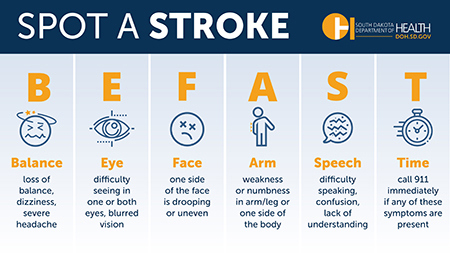A stroke occurs when the blood supply to the brain is suddenly stopped. The majority of strokes are ischemic strokes, which occur when a clot cuts off blood flow to the brain. A hemorrhagic stroke is less common and occurs when a blood vessel ruptures in the brain.
Transient ischemic attacks (TIA), often called mini-strokes, occur when blood flow is temporarily disrupted in the brain. A TIA should not be ignored as they are often the first warning sign of a stroke.
Signs and Symptoms
Learn and share the warning signs of stroke. Don't wait! B.E. F.A.S.T. Call 9-1-1 at the first sign of a stroke.

Balance loss - Is coordination or balance suddenly difficult?
Eyesight change - Is there a sudden change in vision?
Facial drooping - Does one side of the face droop or is it numb?
Arm weakness - Is one arm weak or numb?
Slurred speech - Is speech slurred, are they unable to speak, or are they hard to understand?
Time to call 9-1-1! If the person shows any of these symptoms, even if the symptoms go away, call 9-1-1 and get to a hospital immediately.
Risk Factors and Stroke Prevention
After having a stroke, your risk of having another stroke is high. Some risk factors cannot be changed, such as race, sex, age, and family history. However, there are things you can do to try to lower your chances of having another stroke.
- Manage your blood pressure. Find information on knowing and managing your blood pressure numbers on the Blood Pressure webpage.
- Manage your cholesterol levels. For more information, visit the American Heart Association’s website.
- Maintain a healthy weight, eat healthy meals, and stay active. The American Heart Association's website offers tips and recipes.
- Quit smoking. Visit the SD QuitLine or call 1-866-SD-QUITS (737-8487) for tools and support to quit tobacco.
- Manage your diabetes. People with diabetes can lower their risk by controlling their blood glucose, blood pressure, and cholesterol.
- Take all your medications as prescribed.
- Attend your follow-up appointments as scheduled.
